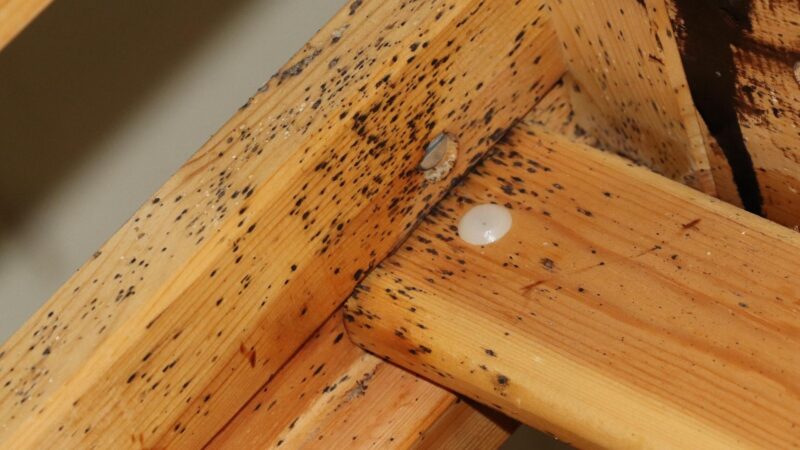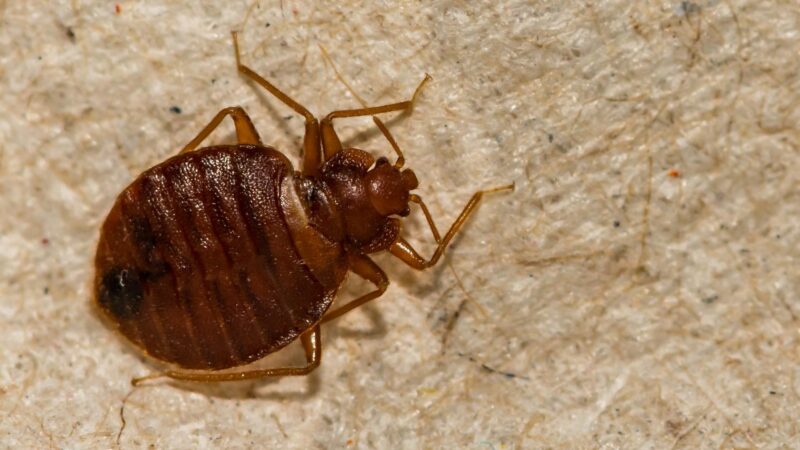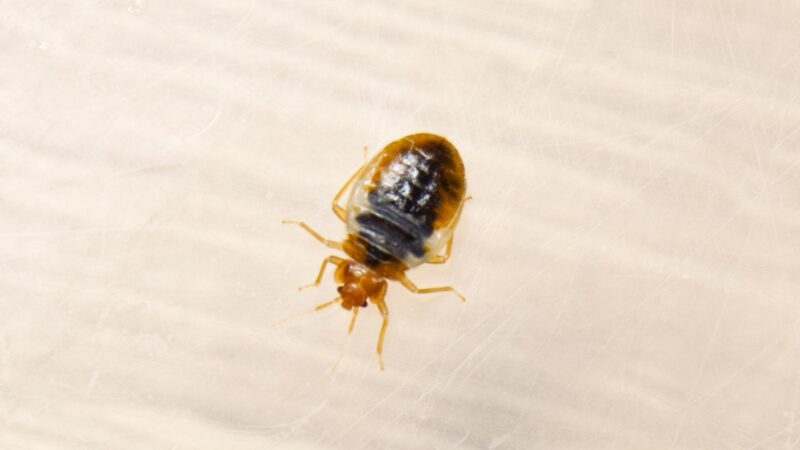Bed bugs don’t transmit diseases but are horrible pests that will let you sleep comfortably. They are incredibly small and usually attack while humans are sleeping.
Although they are mostly found in beds, these notorious creepy critters are very adaptable to any kind of furniture, including plastic, metal, and wood.
Can bed bugs live in wood furniture? Bed bugs live in wood furniture, including tables, chairs, and beds. These bloodsuckers squeeze their tiny bodies to hide in small gaps in any kind of wood, especially where humans and pets spend most of the time. Bed bugs are most common in second-hand furniture.
Bed bugs don’t live in their host but are very determined to suck blood from their victims. These pesky critters patiently wait for the right time to come out and will hide again after their attack.
Fortunately for you, this article discusses bed bugs in wood, signs of future infestation, and how to get rid of them as early as possible.
Table of Contents
Can Bed Bugs Live in Wood?

Bed bugs can live in wood, provided that it is near their food source. However, they don’t really live inside the wood. Instead, they use wood as their hiding spot and breeding site, as long as it has tiny gaps.
However, they will prefer living in the wood, where people usually stay for a long time or sleep at night.
Can Bed Bugs Live on Wood Floor?
Bed bugs do live on wooden floors. They can also hide in gaps between the tiles on the floor. In fact, bed bugs don’t have any problems crawling on all kinds of hard surfaces, including concrete.
These pesky pests cannot move through concrete, but they can penetrate tiny holes or climb into walls and ceilings.
Nonetheless, bed bugs are very unlikely to stay long on the wood floor. First of all, most people don’t sleep on the floor unless they have no bed or sofa. If the wood floor has no tiny holes, bed bugs will not lay eggs on it.
Bed bugs also don’t burrow on wood and will only search for wood that has very tiny crawl spaces.
Can Bed Bugs Live In Solid Wood Furniture?
Bed bugs cannot live in solid wood furniture, which is usually made of oak, maple, or walnut. Some cabinets, chairs, tables, and bed frames are made of solid wood.
With solid wood furniture, the wood has been cut directly from the tree. Since it has no hollow spaces, bed bugs have almost no areas to hide in.
But because solid wood is hard, beg bugs can use it to move from one place to another. Unless the solid wood is smooth, they can also climb on it, vertically and horizontally.
On the other hand, bed bugs can live in engineered wood furniture. Although it is cheaper than solid wood, termites can damage or chew holes in it.
What Kind of Furniture Do Bed Bugs Live In?

Bed bugs usually live in wood furniture, but they may also stay in metal and plastic furniture. If the furniture has no cracks or tiny gaps on the top surface, bed bugs will hide on the sides, under, or behind it.
The smart bugs will only come out once a person or pet is nearby. Bed bugs can also infest upholstered furniture.
Do Bed Bugs Like Wood?

Bed bugs like wood a lot. Although they also like fabric, metal, or plastic, bed bugs prefer wood because of its attractive characteristics.
Aside from being warm, wood has moisture and usually has cracks and tiny spaces where they can hide and lay eggs. Plastic and metal are smooth and rarely have holes.
Do Bed Bugs Eat Wood?
Bed bugs don’t eat wood as termites do. These bugs have no teeth so they cannot eat anything, including wood. Their jaws are not designed for chewing, making them incapable of burrowing into wood.
Once bed bugs suck blood from humans or animals, they pierce the skin using their elongated mouthparts.
Signs of Bed Bugs in Wooden Furniture

Adult bed bugs are usually reddish-brown and have oval, flattened bodies that are about 1/4 inches (6.35 mm) long. Nymphs (immature bed bugs) are mostly yellowish-white and measure about 1/6 inches (4.23 mm) long.
On the other hand, bed bug eggs are white and oval and also measure about 1/6 inches long.
Bed bugs go through incomplete metamorphosis, which means they have no pupal stage. Considering their very small size, and they can crawl into dark, tiny spaces very fast, bed bugs are very difficult to find.
If you cannot find any bed bugs on your wood furniture, here are some notable signs of their presence:
1. Bed Bug Bites
Bed bug bites look similar to mosquito bites and some other insect bites. Both of them leave red, bumpy marks on the skin.
However, bed bug bites are usually in a straight line, while mosquito bites are mostly in a random pattern. But more importantly, you can only feel the itchiness of bed bug bites after several hours.
2. Bed Bug Poop
Unfortunately, some people may not react to bed bug bites and will not have any bite marks. But still, bed bugs cannot hide their poop. So, if you spot some blood stains on your wooden furniture, it could be bed bug poop.
These dark spots are digested blood that bed bugs expel while they are feeding.
3. Bed Bug Cast Skins
Before bed bug nymphs become adults, they will undergo five instar stages, which can last for several weeks. This can be longer if there is a shortage of blood meals. Immature bed bugs will cast their skin for every instar stage.
Shell casing of bed bugs are translucent and have hollow outlines of their bodies.
4. Bed Bug Odor
Bed bugs release a musty odor, which can be compared to the smell of berries. This moldy smell gets stronger as the number of bed bugs present increases.
However, you may only notice this if there is already a huge bed bug infestation. Sometimes, it is overpowered by the rusty smell of bed bug feces.
Related: Early Warning Signs of Bed Bugs Infestation | What Does It Mean?
Do You Have to Get Rid of Furniture if You Have Bed Bugs?
You don’t have to get rid of your furniture even if you have bed bugs. In most cases, they can still be treated. If you throw them away, there could still be some bed bugs hiding somewhere.
Therefore, this is not the proper solution to get rid of bed bugs. You should treat the furniture and kill the bed bugs in that area.
How Do You Get Rid of Bugs on Wood Furniture?
As mentioned above, throwing away furniture with bed bugs will not solve the problem. Instead of buying a new one, which can be expensive, try removing all the bed bugs on your furniture.
Regardless if it is a bed, a table, or a cabinet, here are some useful tips on how to get rid of bed bugs on wood furniture.
1. Prepare the Necessary Tools
Since bed bugs hide in dark, tiny gaps, you will need some household tools. This includes a flashlight, a playing card or old credit card, a roll of transparent duct tape or plastic shipping tape, and a plastic wrap for the furniture. You will also need a vacuum cleaner, soapy water, or HARRIS Bed Bug Killer, Liquid Spray.
2. Inspect the Wood Furniture
Search all the edges of the wood furniture carefully and patiently. Insert the old credit card or playing card along the cracks and crevices to kill the bed bugs or force them to come out.
Use your flashlight to help you find them. This will also cause bed bugs and their eggs to cast a shadow, so you can easily see them.
3. Kill Bed Bugs on the Furniture
Aside from an old credit card, use the tape to trap or kill the bed bugs on your wood furniture. Alternatively, use a vacuum cleaner, soap and water, or a reliable bed bug killer spray.
Also, check the bottom of your furniture. If possible, move your wood furniture outside the house so bed bugs will not spread to other areas.
4. Kill Bed Bugs on the Bed
If your bed has a box spring, check the seams and edges on the underside. They are also the favorite hiding place of bed bugs in beds.
Remove the loose fabric (or ticking), and check all the sides of the bed frame, screw holes, and headboard. Use a bed bug killer spray to eradicate the bed bugs you can find.
5. Kill Bed Bugs in Mattresses
To kill bed bugs in your mattress, encase it with a mattress cover, such as Utopia Bedding Zippered Mattress Encasement. Keep the mattress covered for at least a year. These bloodsuckers will die of starvation if they have no blood meal for a year. Mattress encasement also makes it easier for you to control bed bugs.
How Do You Make Sure There Are No Bugs in Wood?
Again, wood is the favorite hiding place for bed bugs. Since wood is very useful to us, you should make sure that it has no bed bugs before bringing it inside your house.
This will also prevent possible bed bug infestation in the future. Aside from inspection, here are other effective ways to avoid bed bugs in wood.
- Avoid buying second-hand wood furniture. No matter how convincing the salesman is, used wood furniture is very likely to have bed bugs.
- If you buy second-hand furniture or reclaimed wood, wrap it tightly and place it under the sun for at least 4 hours.
- For small wood items such as a coffee table, wrap them in plastic and heat them at 56°C (133°F) for 3-4 hours. This can kill all life stages of bed bugs.
- Alternatively, freeze the wood at a constant temperature of 32°F (0°F) or lower for several days.
- Don’t let any wood furniture touch the walls or very near them. Otherwise, bed bugs can easily crawl on it.
- For wooden beds and furniture with posts, use interceptor cups such as Climbup Insect Interceptor Bed Bug Trap. Place them on each post to trap bed bugs and stop them from climbing into your bed.
Frequently Asked Questions
What Smells Do Bed Bugs Hate?
Bed bugs can smell the odor of humans. This is why they attack people who are already sleeping. These creepy critters can also smell dirty laundry or bedding, which attracts them to climb into the bed.
Nonetheless, there are also some scents that bed bugs hate. Here are some of the smells that can repel them:
- Bleach
- Diatomaceous Earth (DE)
- Garlic
- Rubbing alcohol
- Vinegar
According to a study, bed bugs also hate the strong smell of some essential oils. This includes blood orange essential oil, cedarwood essential oil, citronella essential oil, clove essential oil, eucalyptus essential oil, lavender essential oil, lemongrass essential oil, neem essential oil, and peppermint essential oil.
What Surfaces Do Bed Bugs Live On?
Bed bugs love to stay on hard and rough surfaces, where they can easily crawl and climb. They tend to avoid smooth surfaces such as glass, linoleum, and some plastic since it will make them difficult to move.
But again, bed bugs will choose surfaces that have tiny gaps and are in dark areas where they can hide.
Do Bed Bugs Live in Walls?
Bed bugs live in walls, but only those with cracks and crevices. As long as they can squeeze their bodies into walls, bed bugs will live within and behind the walls.
Despite not being capable of flying or jumping, they have six strong legs for easy climbing on rough walls. Bed bugs cannot damage the walls, though.
Should I Throw Away My Bed Frame if I Have Bed Bugs?
You should not throw away your bed frame if it has bed bugs in it. Just like furniture, mattresses, and box springs, bed frames with bed bugs can still be treated.
Throwing away an infested bed frame can also help spread bed bugs to other places. The same thing may also happen if you donate it to charity.
Aside from that, if you throw away your bed frame, you will have to sleep on the floor. This will only make it easier for bed bugs to attack you.
Buying a new bed is not a good idea since bed bugs could still be present inside your bedroom. But if you decide to dispose of any infested belongings, you should do it properly.
According to the law, you should cut or destroy infested items and place them in a sealed plastic bag before discarding them.
Put a label, “Bed bug-infested, do not take,” so other people will be discouraged to bring it home and use it. Leave them on the street curb only when the garbage collector has arrived.
Summary
Dealing with bed bugs in wood can be exhausting and time-consuming. These stubborn bugs don’t damage personal belongings.
However, a single female bed bug can cause an infestation sooner than you can imagine. To avoid this from happening, regular checking is required. It’s better to be busy than sorry.
List of Sources
Biology, Habitat, and Management of Bed Bugs